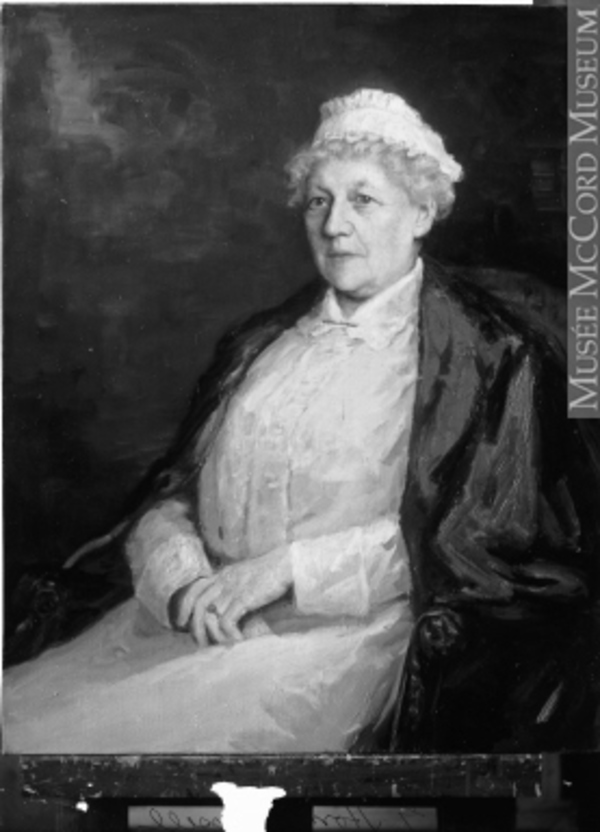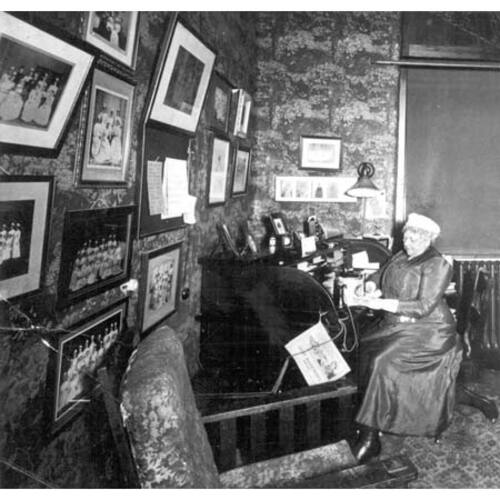
Source: Link
LIVINGSTON, GERTRUDE ELIZABETH (Nora), hospital and nursing school administrator; b. 17 May 1848 in Sault Ste Marie, Mich.; daughter of John Livingston and a woman named Margaret; d. unmarried 24 July 1927 in Val-Morin, Que.
Little is known about the childhood and youth of Gertrude Elizabeth Livingston, who was called Nora. At the time of the 1850 census in Michigan, her father listed himself as a merchant in Sault Ste Marie. He is also known to have been a captain in the British army. When he retired, he moved with his family to Como (Hudson) on Lac des Deux Montagnes in the province of Quebec. Nora left home to train as a nurse at the New York Hospital’s Training School for Nurses. A few years later she received her diploma from this institution, which was renowned for its teaching and was then the school preferred by people in North America who were not in religious orders.
Before hiring Miss Livingston in 1890, the management of the Montreal General Hospital had made several attempts to recruit a competent and efficient superintendent to take charge of the hospital’s overall administration. However, there were differences of opinion within their ranks about the division of duties between the general superintendent and the head nurse, or matron. Responsibility for nursing care and for the supervision of all employees except the physicians was assigned in turn to one or the other, depending on their qualifications. From 1875 to 1877 Maria Machin, the superintendent at St Thomas’s Hospital in London, England, had tried in vain to organize its nursing care. Sent by Florence Nightingale – a pioneer in the training of hospital nursing personnel – at the request of the Montreal General Hospital, Machin had also done her best to establish rules of hygiene and order for it, considering it badly organized and insalubrious. From 1877 to 1887 the medical superintendent had provided training for the nurses by practical demonstrations, while the head nurse was responsible for their supervision, among other things. During these years, the nurses’ difficult work and precarious living conditions resulted in a lot of turnover of staff. The heavy burden of domestic tasks (housecleaning in the wards, strict attention to cleanliness), as well as personal care-giving and the lack of living space were, for example, obvious problems. Furthermore, since Canada had only one school for nurses – the St Catharines Training School and Nurses’ Home, which had opened in Ontario in 1874 – young women attracted to the profession often went to the United States to complete their training. The resignation in 1889 of the hospital’s superintendent, however, would clear the way for someone who would take the situation in hand.
Nora Livingston was working as a registered nurse at the New York Hospital when, on the advice of a family friend, Francis John Shepherd, who was a surgeon at the Montreal General Hospital, she applied for the position of its superintendent. Before accepting the appointment she was eventually offered, she set down her conditions: two experienced nurses of her own choosing would work with her, and her duties would not include any domestic tasks. Her employment began on 20 Feb. 1890 at an annual salary of $800. The hospital had 165 beds at the time and she was responsible for 30 to 35 nurses. She promptly rearranged the duties of the staff and made preparations to open a school for nurses of which she would be in charge, at the behest of the hospital’s medical board. The first students arrived on 1 April 1890. In July she reported that 30 were already enrolled, chosen from among 180 applicants. After a probationary period of two months, the candidates studied for two years, and then received their diplomas as nurses. The first graduation ceremony was held in April 1891, for six nurses whose experience had enabled them to complete the course in one year. For this occasion, she followed the example of physicians and instituted a code of ethics requiring the new nurses to take an oath (a practice rare in Canada at the time, but found in the United States).
In 1894, following a proposal made by an American nursing school and in response to pressure in favour of giving professional status to nurses, the duration of the course was increased by a year and a committee was set up to coordinate its content. In 1899 the superintendent and the medical board drew up a definitive training program that established the length and sequence of courses over the three years and provided for the monitoring of every student. The teaching was done by the superintendent, assisted by two registered nurses, and by members of the medical board. The hospital would not hire a full-time teacher for the school, Flora Madeline Shaw, until 1906.
At the hospital, Livingston looked after all matters related to the nurses: their training, recruitment, dismissals, working conditions, and so forth, although in such matters as the discharging or hiring of a nurse, she had to obtain the prior agreement of the board of governors. She had a great deal of authority over nurses and nursing care.
As one of the leading members of her profession, Livingston had a lofty concept of her mission and took great care to see that the hospital’s school acquired an enviable reputation all across Canada. The selection of students, sound training, and strict discipline in work and life were her means to this end. In 1910 she objected to the fact that candidates from other establishments were coming only for the final part of their training. According to the minutes of the management committee meeting of 6 April, to allow this practice “might give the public the idea that the graduates of such institutions possessed equivalent standing to our own nurses. . . . To place the stamps of the Hospital’s Training School upon diplomas of minor institutions would tend to induce prospective applicants to enter those institutions offering the least resistance.” Livingston insisted that candidates have a superior academic background. She imposed draconian rules of conduct on the students and nurses hired by the hospital, and she regulated conditions of work and training as well as rest periods, stipulating a precise bedtime, a fixed number of visits outside the hospital, the wearing of a uniform, and so on. Any violation of discipline was generally punished severely. On several occasions recalcitrant nurses were dismissed from the school or suspended for several months.
The management of the hospital recognized Livingston’s competence. In 1903 she even got them to agree that only its own graduates could work in its private wards, unless there were exceptional circumstances. The 1910 rules for the employees gave full authority to the superintendent – a further indication of its confidence in her.
By reorganizing the work, gradually encouraging the appointment of nurses to positions of responsibility, and establishing specific duties, Livingston helped to define the proper functions of a nurse. In 1890, for example, with the agreement of the board of governors, she hired a boy to carry medicine from one ward to another. In 1894 the nurse in charge of the scarlet fever department managed to get a housekeeping assistant hired. These temporary employees freed the nursing staff from duties not directly related to the care of patients. In this way, the Montreal General Hospital’s school built a solid reputation both in the English-language hospitals of Quebec and in the rest of Canada. Affiliated to McGill University’s faculty of medicine, it ushered in a new era in nursing care.
After some 30 years of service to the hospital, Nora Livingston had achieved her objectives. She was recognized as a pioneer by her profession and received many marks of distinction, including the founding of the Livingston Club in 1905 and the creation of the Nora Livingston Scholarship Fund in 1940. Nursing was now distinguished from domestic tasks, nurses were trained in an appropriate school, and the care of patients was the exclusive responsibility of a superintendent determined to impose extremely strict professional standards. Livingston had played a decisive role in the development of the nursing profession. The model she had established at the Montreal General Hospital would later become a guide for smaller hospitals elsewhere in the province and throughout the country that wanted to set up such a structure.
Despite extensive research, no record of Gertrude Elizabeth Livingston’s birth record has been found.
MUA, MG 3099; RG 96, c.23, c.26–34, c.37, c.405, c.421. Gazette (Montreal), 25 July 1927. Yolande Cohen et Michèle Dagenais, “Le métier d’infirmière: savoirs féminins et reconnaissance professionnelle,” RHAF, 41 (1987–88): 155–77. D. MacL. Jensen, History and trends of professional nursing (9th ed., St Louis, Mo, 1950). H. E. MacDermot, History of the School of Nursing of the Montreal General Hospital (Montreal, 1940; repr. 1961). Barbara Melosh, “The physician’s hand”: work, culture and conflict in American nursing (Philadelphia, 1982). Michigan 1850 census index, ed. R. V. Jackson and G. R. Teeples (Bountiful, Utah, 1978).
Cite This Article
Yolande Cohen, “LIVINGSTON, GERTRUDE ELIZABETH (Nora),” in Dictionary of Canadian Biography, vol. 15, University of Toronto/Université Laval, 2003–, accessed January 1, 2026, https://www.biographi.ca/en/bio/livingston_gertrude_elizabeth_15E.html.
The citation above shows the format for footnotes and endnotes according to the Chicago manual of style (16th edition). Information to be used in other citation formats:
| Permalink: | https://www.biographi.ca/en/bio/livingston_gertrude_elizabeth_15E.html |
| Author of Article: | Yolande Cohen |
| Title of Article: | LIVINGSTON, GERTRUDE ELIZABETH (Nora) |
| Publication Name: | Dictionary of Canadian Biography, vol. 15 |
| Publisher: | University of Toronto/Université Laval |
| Year of publication: | 2005 |
| Year of revision: | 2005 |
| Access Date: | January 1, 2026 |




